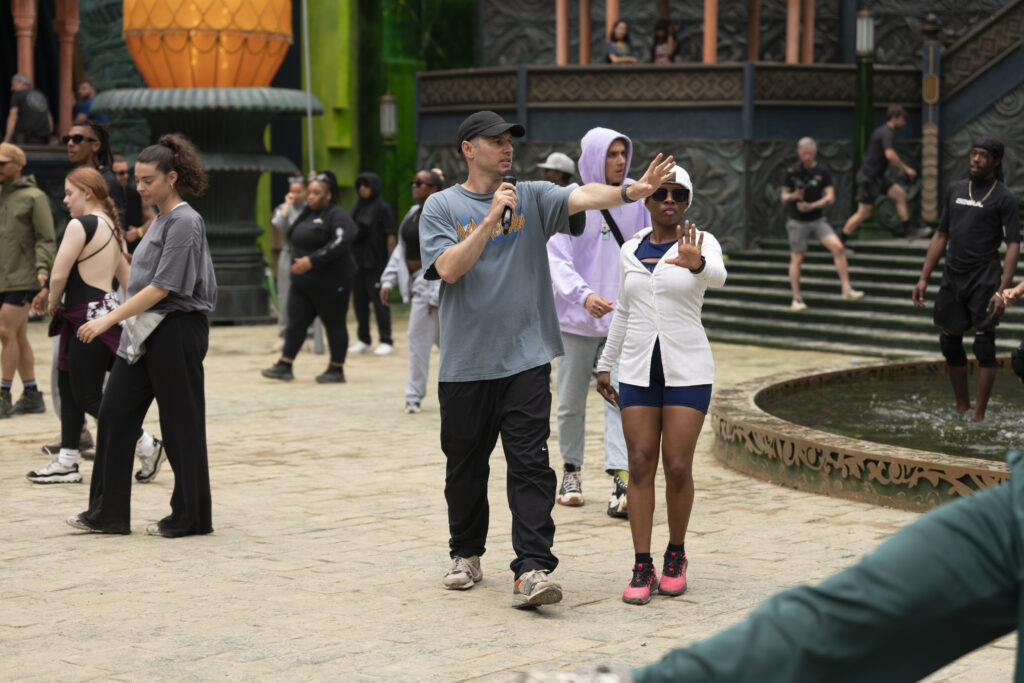 Christopher Scott. Photo by Sophy Holland, courtesy Universal Pictures.
Christopher Scott. Photo by Sophy Holland, courtesy Universal Pictures.
When Christopher Scott became the choreographer for the film Wicked, he wasn’t in a meeting or on a phone call. He was at the home of his longtime friend, the film director Jon M. Chu. Chu simply handed Scott a hat decorated with the Wicked logo and said, “Are you ready?” That’s how Scott knew it was real, he says, “And then the journey began. And it was one of the craziest journeys of my life.”

According to Scott, the path to Wicked started 16 years ago, when he worked with Chu on Step Up 2: The Streets. Since then, the Emmy-nominated choreographer has done numerous TV and film projects and worked with celebrities like Miley Cyrus and Selena Gomez.
On Choreographing for the Movie’s Star-Studded Cast
Scott approached the process of creating movement for Wicked as a collaborative exploration. First, he sat down with each cast member to discuss their version of their character, so that his choreography could enhance, rather than conflict with, their vision. “It was amazing how much information they had at the beginning, how thoughtful they were from the day they came into the first rehearsal.”
Scott recalls adapting a particular facet of Elphaba’s choreography with Cynthia Erivo and associate choreographer Comfort Fedoke: Although Elphaba is ridiculed for her dancing in one scene, the three agreed that it’s not about her being a bad dancer. She is elegant and comes from a wealthy family. The choreography has to focus on the fact that she is different. “Elphaba does have a voice through movement, but it’s a very specific voice and it’s different,” says Scott. “And that’s who she is, she’s just different.”
 Scott working with Cynthia Erivo on set. Photo courtesy Universal Pictures.
Scott working with Cynthia Erivo on set. Photo courtesy Universal Pictures.
For Ariana Grande’s Glinda, Scott says that humor, experimentation, and play led to many of their breakthroughs, citing Grande’s brilliant comedic timing. He recalls trying ideas that seemed “far out” and watching them come to life beautifully on her. “When you’re focused on the authenticity of the characters, it kind of helps weed out things that work and things that don’t work.”
Scott notes that his experience choreographing hip hop informs everything he does, including Wicked. “What I love about hip hop is it’s birthed out of BIPOC communities, and it came from a place of oppression, so I think when you’re dealing with representing a world on film, it’s very powerful to be able to pull from those styles…it brings a reality to something even as larger-than-life and surreal as Oz.” For the movie, he integrated numerous dance styles for the sake of creating movement that was relatable. Then, to prevent the choreography from feeling overly familiar, he added small twists to create an “Ozian” feeling.
 Photo courtesy Universal Pictures.
Photo courtesy Universal Pictures.
Creating a kind of map of movement, Scott thought out each region of Oz carefully in terms of history, function, even socioeconomic class. The Emerald City, for instance, is a true melting pot of styles—vogue-inspired, popping, and Afro dance—while Gillikin country is lifted, dainty, and balletic. Munchkinland is grounded in ritual and is communal, and Winkie country is rhythmic, conjuring the image of boots stomping the ground, inspired by the influence of the military presence from the Winkie culture.
On Choreographing for the Screen vs. the Stage
When asked about his approach to working on Wicked after having seen the Broadway show seven times over the years (at least), Scott explains: “I wanted to create something original for the film because we had the opportunity to do a lot of things that you can’t do onstage. But at the same time, I wanted to pay homage when I could to the incredible work that Wayne (Cilento) did.”
 Ethan Slater and Marissa Bode. Photo by Giles Keyte, courtesy Universal Pictures.
Ethan Slater and Marissa Bode. Photo by Giles Keyte, courtesy Universal Pictures.
There was one moment, says Scott, during filming when he was truly in awe. Most of the time, he and his assistant and associate choreographers were glued to the monitor, zoned in on what minute changes could make the next take better than the last. But after nailing a swirling, sliding shot of parkour performer Ed Scott flipping through the air from one platform to another, he says, he sat back and felt really proud.
As far as what Scott hopes audience members take away from the film, there are a few things. He wants people to be moved by the story of Wicked and to feel seen. He also hopes that audiences pick up on the narrative woven throughout his choreography. “It’s a craft that’s so tied into storytelling and has so many nuances…it’s not just getting somebody to make up a bunch of dance steps.” Indeed, in Scott’s life and in the film, dance feels like a language or an emotion, something with an innate ability to connect people and express the inexpressible. “It’s a human thing that we do.”
 Jonathan Bailey as Prince Fiyero. Photo by Giles Keyte, courtesy Universal Pictures.
Jonathan Bailey as Prince Fiyero. Photo by Giles Keyte, courtesy Universal Pictures.
Source link




GIPHY App Key not set. Please check settings